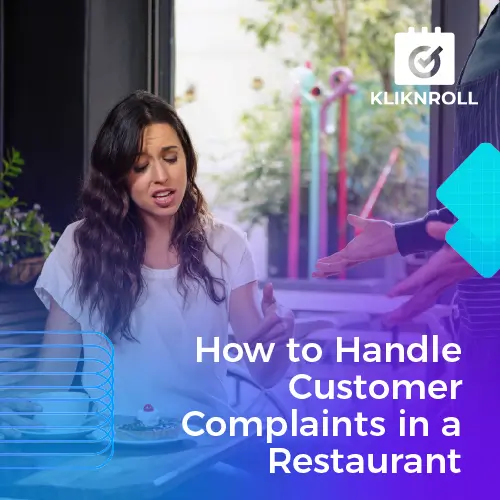Key Takeaways of this Article
Handling customer complaints effectively in a restaurant is one of the foundations of a successful and long-lasting restaurant.
The team here at KlikNRoll has got more than a decade of experience and knowledge at this point, so we feel like we can point you in the right direction.
We’ll also go over some practical examples alongside an action plan that you can implement right now. Stick around, you might learn a thing or two by the end of this article!
6-Step Action Plan on How to Handle Customer Complaints
1. Be Polite, Even if Your Customers Are Not

As restaurant management, it’s important to handle customer complaints with professionalism and courtesy, even in difficult situations.
Regardless of how upset or difficult a customer may be, remember that they took the time to come and support your restaurant.
Stay calm, try to maintain a friendly demeanor, and respond with politeness. A sudden outburst won’t benefit you in the long run. This approach not only diffuses tense situations but also reflects positively on your restaurant’s commitment to great customer service.
It’s important to convey to your waitstaff the importance of maintaining composure, as they are the face of your restaurant, and could ultimately make or break the customer journey.
2. Be Understanding and Empathetic
Empathy is a staple of effective complaint resolution. Put yourself in your customer’s shoes and genuinely understand their point of view.
No one likes the feeling of getting ignored when raising a complaint – so it’s the job of restaurant management to make the customer feel valued so that they would come back as returning customers.
Perhaps their expectations weren’t met, or certain circumstances led to a negative experience.
Show empathy and convey that you genuinely care about their concerns. This sense of understanding creates a connection, and customers will appreciate your willingness to listen and address their issues.
3. Apologize and Ask for Feedback
A sincere apology can go a long way in diffusing customer dissatisfaction. It’s important to acknowledge the problem and apologize for any inconvenience or disappointment they might have experienced.
After that, try asking for feedback. This not only shows your dedication to improvement but also lets the customer know that their input is valued.
By encouraging them to share their thoughts, you signal that their feedback matters. You can also take this opportunity to jot down what complaints they had and try to improve in the future. This is something that we’ll touch on in the coming points.
4. Offer or Discuss a Win-Win Solution
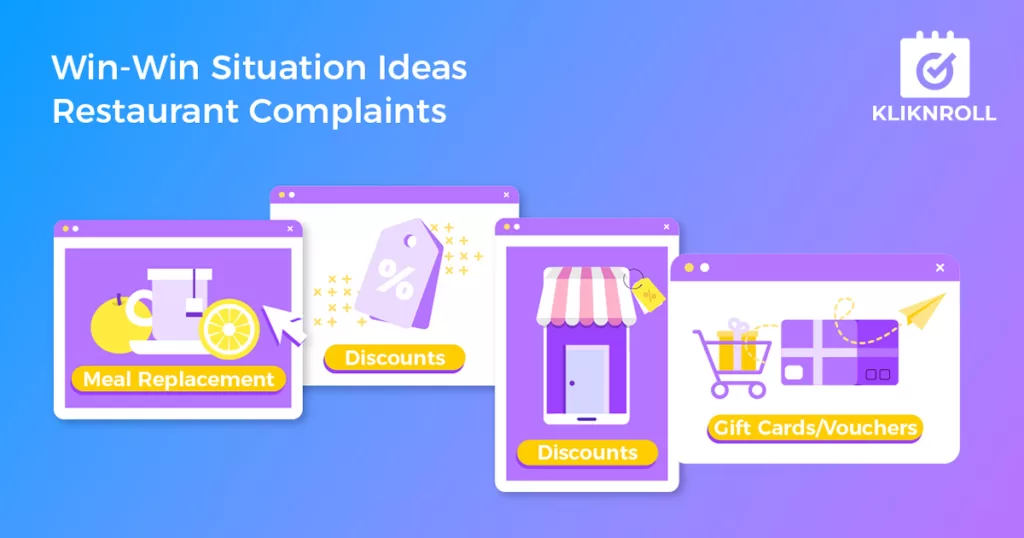
When handling customer complaints, always aim for a win-win solution. After understanding their concerns and apologizing, have a conversation about potential solutions.
What can you do to prevent this from happening again? What can you offer as compensation?
Find a common ground where both the customer and your restaurant can benefit. This can be in the form of offering a replacement dish, a discount, or a complementary item.
Besides those, you can utilize gift cards/vouchers as a win/win solution. Replacing a dish and discount doesn’t guarantee a returning customer.
So what you can try to do is give them a voucher or a gift card that they can use for their next visit.
This encourages them to give you another shot. Which ultimately means a second chance to gain a loyal customer – turning a critic into potentially a member of your loyalty program!
The objective is to resolve the issue to the customer’s satisfaction while making sure it’s not too costly for your restaurant, as well as try to gain and retain loyal customers!
5. Fix the Problem and Make Sure It's Improved
Once you’ve agreed on a solution, make sure it’s quickly put into action. Whether it’s replacing a meal, addressing an issue, or making a change in your service, follow through on your commitment.
Make sure that the problem is resolved and that the customer’s experience is improved. This shows your commitment to not only addressing the immediate concern but also preventing similar issues in the future.
A win-win situation that we’ve discussed earlier will usually shift a bad customer experience into a good one since you’ve formed a connection and gone above and beyond to resolve the issue!
6. Follow Up & Personalize the Experience
After resolving the issue, don’t let the customer relationship end there. A thoughtful follow-up is a powerful tool.
Reach out to the customer to inquire about their experience after the complaint was addressed.
Personalize this interaction by using their name and referring to the specific issue they had. During this time, you should aim to request an online review, preferably one detailing how you managed to fix the issue for them.
Online reviews are extremely important, not just because they have similar power when compared to word-of-mouth.
They also help your restaurant rank better on Google, Yelp, or Trip Advisor as more positive reviews equal a higher ranking.
It shows your genuine care and commitment to their satisfaction, leaving a lasting impression and potentially turning an upset customer into a loyal, repeat customer.
Common Restaurant Complaints from Customers
Not that you’ve familiarized yourself via our 6-Step Action Plan. Let’s take a look at some practical examples of customer complaints and how you can solve them using the action plan!
The Food Wasn't to their Expectations
Everything else aside, the main reason for people dining out is for food. Food is the one single thing that makes or breaks most restaurants.
You can have the best service in the world, but if the food isn’t good, you’re going to have unhappy customers who are not returning.
Some of the most common culprits in this category are:
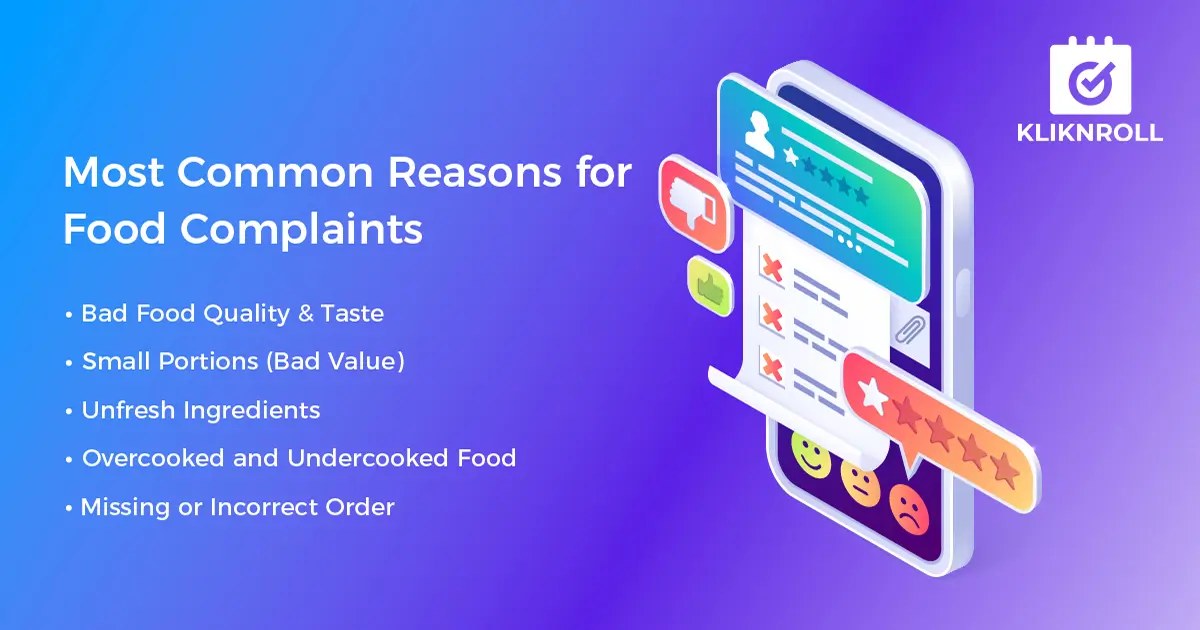
- Overall Food Quality & Taste
- Small Portions in Proportion to Price
- Ingredients That Were Not Fresh
- Overcooked or Undercooked Food
- Missing or Incorrect Orders
As you can see, this category is extensive and there are various factors affecting food expectations.
Luckily though, according to our clients’ experience, most customers are happy with a replacement, be it the same dish remade or a different dish entirely.
Despite this, the odds of them being returning customers are considerably lower. So what can you do to combat this and turn them into regulars?
The answer is simple – provide more value and care. It could be something as easy as giving a discount or maybe a voucher for future visits.
The key is to show that you care about their experience and give them an incentive to come back and give you a second shot!
Wait Times are Just Too Long
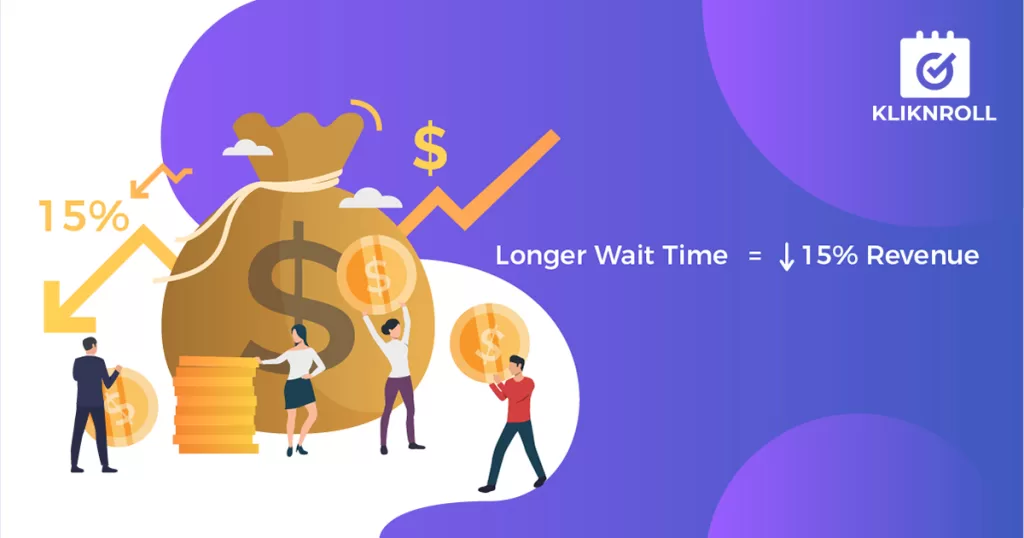
Wait times are something that can make or break a restaurant experience, whether it be seating or food wait times.
A study done by Jelle De Vries (you can check it out here on ScienceDirect), shows that restaurants are losing out on potentially 15% of revenue due to long wait times.
The change in customer spending behavior mainly causes this due to said long wait times – as they tend to spend less the longer they wait. As expected, the likelihood of them returning also decreases.
To fix this, you can streamline your restaurant’s operation processes. The first and most obvious way to smoothen out the seating process.
Most restaurants have long wait times mainly because of a sudden influx of diners at any one given time (most likely from 12 to 3 for lunch, and 6 to 9 for dinner).
To address the issue of extended wait times in restaurants, especially during peak hours, we at KlikNRoll has developed an efficient online booking system. This system helps streamline the reservation process, allowing restaurants to:
- Decrease Wait Times and Boost Revenue.
- Allocate Staff and Ingredients in Advance.
- Reduce No-Shows.
- Gather Valuable Customer Data to Improve Future Efficiency.
By using KlikNRoll’s online booking system, you can enhance the dining experience, boost customer satisfaction, and ultimately increase revenue.
It’s a solution that not only simplifies the reservation process but also addresses the pain points of long wait times, making dining out a more enjoyable experience for customers.
Plus, you don’t have to be restricted by using a third-party platform. We understand the value of branding and customization, so we made sure to let you change and edit anything you can imagine on our platform.
Take a look at our product page, and contact us so that we can show you a demo of what KlikNRoll can do!
Inconsistent Quality Among Regulars
Regular customers are the backbone of any successful restaurant. They keep coming back because they love what you serve, and they have a reasonable expectation of consistency during each visit.
But here’s the kicker: even some of the most enduring restaurants aren’t solely known for culinary greatness. They thrive because they’ve mastered the art of delivering consistent quality, time and time again.
Think about it this way – a restaurant that offers above-average food with stable consistency often outshines the competition.
On the flip side, a restaurant with top-tier food but a lack of consistency can find itself struggling.
Now, we’re not suggesting you aim for absolute perfection in every aspect; that’s a tall order for many restaurants.
Instead, focus on getting the top 10 most popular items on your menu right as consistently as you can.
This practical approach lets you achieve 80% of the desired results with just 20% of the effort. Perfecting these key menu items is a low-hanging strategy that’s not only cost-effective but also brings massive results.
Rude Service or Lack of Attentiveness from Waitstaff
Service, often considered the second most crucial aspect after the food itself, holds great importance for customers.
Their expectation is clear – courteous and attentive service. Yet, a common gripe among customers is encountering rudeness or inattentiveness from the waitstaff.
Addressing this issue stands as a linchpin in maintaining a positive reputation and nurturing customer loyalty.
Now, what fuels this behavior? Picture your staff under immense stress and pressure, particularly during peak hours.
This stress, coupled with understaffing, can undoubtedly take a toll. They end up juggling more tables and handling a larger number of customers, which can breed impatience and impact their overall demeanor.
Furthermore, understaffing can result in your staff working extended hours, a challenge for anyone.
During these bustling periods, miscommunications and misunderstandings can occasionally rear their heads, both among the staff and with customers.
But, always remember, your waitstaff are human too, and like all of us, they have their off days. It’s crucial to convey that the workplace isn’t a suitable place to vent frustrations.
In essence, it all boils down to effective management-to-employee communication. Being understanding and lending an ear to your staff’s concerns can significantly improve their treatment of both you and your customers.
Lastly, remember that great training goes hand-in-hand with having outstanding waitstaff. For insights into the essential skills that any competent waitstaff should possess, you can explore Indeed’s informative article on the subject here.
Wrong Order or Special Request Not Honored
This aspect, like our previous discussion, carries a more serious weight. It’s vital to not only acknowledge but meticulously honor special requests from your diners.
These requests can stem from personal preferences, dietary restrictions, or, importantly, critical health considerations.
Food allergies, for instance, can pose life-threatening risks. The FDA has classified the most prevalent food allergens as follows:
- Milk and Dairy
- Eggs
- Fish
- Crustacean Shellfish
- Nuts
Considering that over 220 million adults worldwide grapple with some form of food allergy, rigorous measures are imperative.
One effective approach is to appoint an Expediter, a pivotal figure responsible for rigorously inspecting each dish to ensure it complies with the customer’s specific requirements.
Implementing and enforcing a strict kitchen SOP (Standard Operating Procedures) is a great way to prevent miscommunications, properly handle allergens, prevent cross-contamination, and staff training.
Moreover, to reduce the complaints in this regard, having an allergen disclosure next to menu items is a great way to prevent miscommunication, and let your customers know that they probably should steer away from certain dishes.
This also has the added benefit of protecting you in case of any disputes that might come if something were to go wrong.
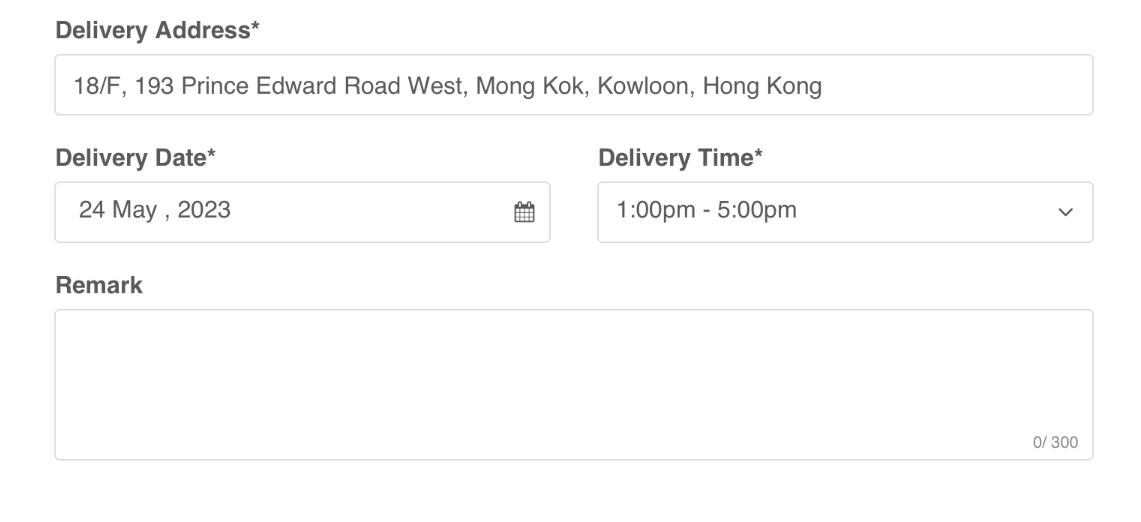
The KlikNRoll platform allows your customers to input special remarks so you won’t be put in an awkward situation. This feature is available for delivery as well as dine-in!
Why It’s Important to Handle Customer Complaints Properly
Let’s talk about why it’s important to handle customer complaints the right way in your restaurant.
First off, when customers aren’t happy, they often take to social media to air their grievances, which can do some damage to your restaurant’s reputation in the long run.
The same unhappy customers might spread the word to their friends and family, who take their opinions seriously, this is also called word-of-mouth – the most powerful type of advertising.
So, if you don’t address these complaints properly, you could end up with a bad online rep and fewer customers coming through your doors.
But there’s a silver lining here – handling complaints well can not only prevent bad online reviews but can also turn those unhappy customers into your biggest advocates if you handle things right.
Another big reason to tackle complaints head-on is that it shows your customers that you genuinely care about what they have to say.
It’s all about empathy and professionalism. By doing this, you’re setting the stage for long-term customer loyalty. Think of it as building trust between your restaurant and each customer, one complaint at a time.
Now, here’s the neat part – dealing with complaints also gives you a chance to improve and get better.
It can also lead to more loyal customers in the long run. When customers share their feedback, even if it’s in the form of complaints, you’re getting valuable information.
You can quickly identify problems and come up with smart solutions, whether it’s about your food, service, or how your place runs.
And that’s not all, it’s also a great way to get feedback on how you can make your staff even better at what they do.
Well-trained staff means fewer complaints and happier customers. So, think of it this way – handling complaints properly isn’t just about fixing problems; it’s about creating a solid foundation for your restaurant’s success and building lasting relationships with your customers.
Again, if you’re interested in our booking software and how it can help you handle customer complaints more efficiently, feel free to check out our product page using the button below!

Hey there! I’m Jeffrey Hau, and my journey in the digital world started after I wrapped up my psychology degree at UCLA. Imagine coming back to the bustling streets of Hong Kong from the tech haven of Silicon Valley – it was a whirlwind of inspiration! Seeing how social media platforms were evolving at breakneck speed and realizing the limitations of traditional advertising in this digital age, I decided to dive in.
In 2012, I laid the foundation of Prizm Group. From our humble beginnings, we’ve now blossomed into a global powerhouse with a team of over 200 passionate professionals. Our HQ is right here in Hong Kong, and we’ve spread our wings to SG, AU, NZ, JP, and China.
As a digital problem solver, our team found that several industries are in need of reservation systems, especially for F&B, Hotels, Beauty, and Medical sectors. Our digital magicians started crafting reservation systems tailored to cater to these specific needs. We extended our expertise to e-commerce, voucher management systems, and campaign management systems, combining them into KlikNRoll – an all-in-one solution. We deep dive into various industries, understanding their unique challenges and developing innovative solutions.
We’re not just a company; we’re your dedicated partners in transforming how you navigate the digital landscape. Our passion lies in providing businesses with intuitive and tailored solutions using KlikNRoll’s powerful capabilities.
Ready to embark on this exciting digital adventure with us? Let’s make your brand stand out in the digital jungle!



